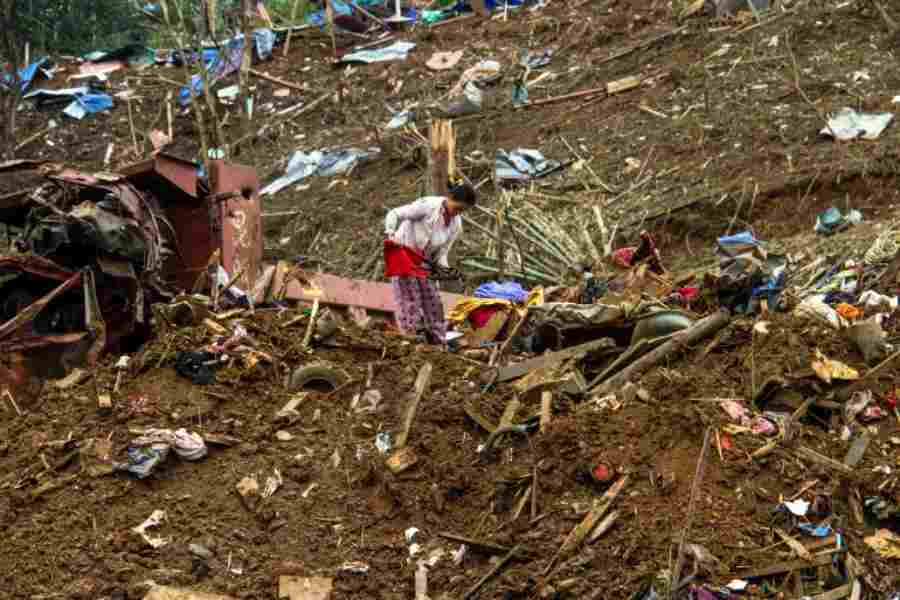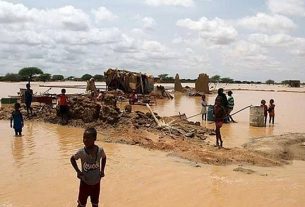![]() A woman looks through the debris after the Myanmar military bombed a camp for displaced people in the country’s north in October [File: AFP]
A woman looks through the debris after the Myanmar military bombed a camp for displaced people in the country’s north in October [File: AFP]
Sat 23 December 2023:
Amnesty International has said the Myanmar military should be investigated for war crimes over a new offensive by an alliance of ethnic armed groups and anti-coup fighters, which has emerged as the biggest challenge to the generals since they seized power in a coup nearly three years ago.
The Myanmar National Democratic Alliance Army (MNDAA), Ta’ang National Liberation Army (TNLA) and Arakan Army (AA) began Operation 1027 in late October in northern Shan state and western Rakhine and claim to have taken control of hundreds of military outposts as well as key towns near the Chinese border since fighting intensified.
Civilian armed groups known as People’s Defence Forces (PDF) that were established in the wake of the coup have also joined the alliance, prompting a furious response from the military and an intensification of the “four cuts” strategy under which it targets civilians to separate the resistance from potential sources of food, funds, intelligence and fighters.
The military has “unlawfully killed, arbitrarily detained and stolen from civilians,” Amnesty said in a report released on Thursday and based on interviews with affected civilians.
The United Nations estimates more than two million people in Myanmar have been forced from their homes by the conflict that has engulfed the country since the military’s February 2021 power grab, with the latest fighting fuelling a growing humanitarian crisis.
“The Myanmar military has a blood-stained resume of indiscriminate attacks with devastating consequences for civilians, and its brutal response to a major offensive by armed groups fits a longstanding pattern,” Matt Wells, director of Amnesty’s crisis response programme, said in a statement. “Nearly three years after the coup, the suffering of civilians across Myanmar shows no signs of easing even as the issue has largely fallen off the international agenda.”
Indiscriminate attacks
Among the incidents detailed by Amnesty was a November 16 attack on Pauktaw town in Rakhine after the AA captured a police station.
After launching a morning attack on the town, the military gave Pauktaw’s 20,000 residents one hour to evacuate.
Some were unable to leave and took shelter in the compound of the Lawka Hteik Pan pagoda on the town’s outskirts thinking that would be safer than their homes.
According to Amnesty, which analysed video and photographs to identify the weapons and military equipment, the military resumed its land, sea and air assault on the town that afternoon with Mi-24 Hind helicopters dropping S-5K rockets and ships firing 40mm high-explosive shells.“The use of these inaccurate weapons in populated areas raises concerns about the Myanmar military’s ability to distinguish between military targets and civilians or civilian objects,” the report said. “The attacks may thus be indiscriminate and, as such, be investigated as war crimes.”
Soldiers then entered the pagoda grounds, according to witnesses who spoke to Amnesty, and arrested the people who were hiding there. Three women, one of them pregnant, were killed, the witnesses said.
More than 100 people, some of them with their hands tied behind their backs, were forced to remain outside the compound during the night despite heavy rain, while others were locked inside the prayer hall where they told Amnesty they were denied food and water for two days.
The military also harassed residents who had stayed in their homes, according to the report, arresting any men and stealing families’ valuables, which is also a violation of international humanitarian law.
The AA pushed the military out of Pauktaw on November 21 and freed those held in the Lawka Hteik Pan compound. As people fled, the military continued its attacks on the town, with satellite imagery obtained by Amnesty showing extensive burning and the destruction of probable civilian homes, a market and areas around religious sites.
Before Operation 1027, the AA had agreed to an increasingly shaky ceasefire in Rakhine, where the military in 2017 led a brutal assault on the state’s mostly Muslim Rohingya forcing hundreds of thousands of people into neighbouring Bangladesh. The crackdown, in towns and villages that included Pauktaw, is now the subject of a genocide case at the International Court of Justice.
Amnesty also documented – using video and analysis of photos of ordnance scrap from the scene – what it said was probably a nighttime cluster munition attack on Namkham township in Shan state.
A cluster munition is a bomb that opens in the air and releases smaller “bomblets” across a wide area. While the bomblets are designed to hit multiple targets such as tanks and troops at the same time, their broad range and the fact that many bomblets do not explode on impact puts civilians at risk.
“The tail kit, exposed electronics, and internal plumbing of the (cluster munition) dispenser scrap in the photographs match the remnants of previous cluster munitions used in attacks by the Myanmar military,” the report said, noting previous incidents in Chin, Kayah and Kayin states last year.
A convention banning the use of cluster bombs has been joined by more than 120 countries.
The United Nations and others have already called for investigations into abuses and potential war crimes by the Myanmar military in its efforts to stamp out resistance.
______________________________________________________________
FOLLOW INDEPENDENT PRESS:
WhatsApp CHANNEL
https://whatsapp.com/channel/0029VaAtNxX8fewmiFmN7N22
![]()
TWITTER (CLICK HERE)
https://twitter.com/IpIndependent
FACEBOOK (CLICK HERE)
https://web.facebook.com/ipindependent
Think your friends would be interested? Share this story!





